소개
그만큼 Commercial tomato sauce making machine is an essential solution for modern food processing industries, enabling manufacturers to produce high-quality tomato sauce efficiently and consistently. Tomato sauce is a staple in households and restaurants worldwide, and its production requires a series of carefully designed machines working together in a production line.
We provide a detailed overview of the components of a commercial tomato sauce production line, including their functions, technical features, and advantages. By understanding the entire process, food manufacturers can optimize efficiency, maintain hygiene standards, and produce tomato sauce that meets consumer expectations.
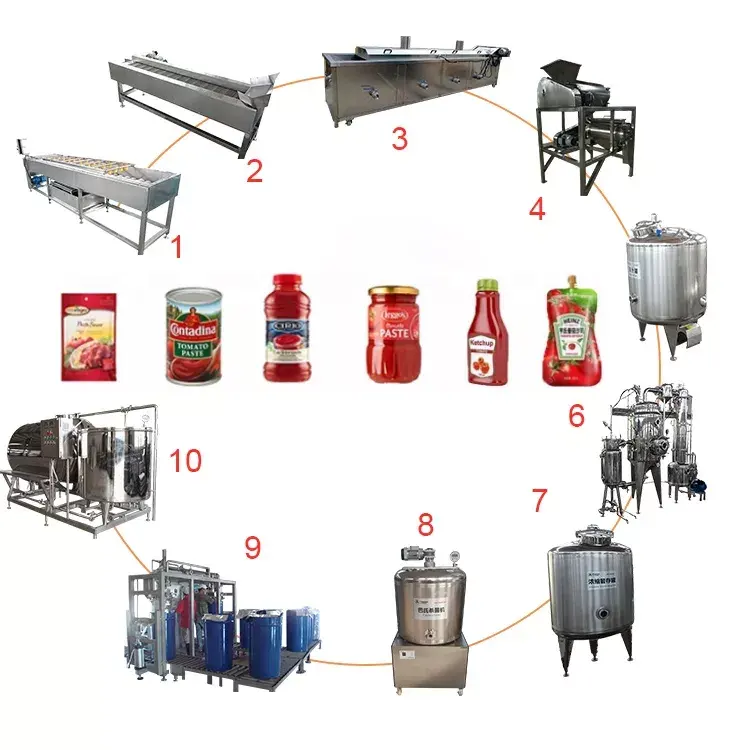
1. Tomato Receiving, Washing, and Sorting System
1.1 Tomato Receiving
Raw tomatoes are the primary raw material for any commercial tomato sauce production line. Tomatoes are first received and stored in bins or silos designed to prevent damage and contamination. Proper handling ensures the quality of the raw material before processing.
1.2 Tomato Washing Machine
The first processing step is washing, which removes dirt, pesticides, and impurities. A typical Commercial tomato sauce making machine line includes a washing system equipped with:
- Water tanks: Submerge tomatoes for cleaning.
- Bubble generators: Produce bubbles to dislodge dirt.
- Rotating brushes: Gently scrub the tomato surface.
Benefits:
- Reduces microbial contamination
- Protects the integrity of tomatoes
- Prepares tomatoes for further processing
1.3 Tomato Sorting Machine
Sorting is vital to ensure uniform sauce quality. Commercial sorting machines:
- Remove unripe, overripe, or damaged tomatoes
- Use optical sensors, color detection, and size grading
- Transport sorted tomatoes to crushers via conveyor systems
Sorting guarantees consistent flavor, color, and texture of the final product.

2. Crushing and Pulping System
Once tomatoes are washed and sorted, they are crushed and pulped to extract juice and pulp. This step is critical for achieving smooth, homogeneous tomato sauce.
2.1 Tomato Crusher
- 기능: Breaks whole tomatoes into smaller pieces.
- Mechanism: Uses rollers, knives, or hammer crushers.
- 용량: Commercial crushers can process 500–5,000 kg/h depending on the model.
2.2 Tomato Pulper
- 기능: Separates tomato seeds and skins from pulp.
- Mechanism: Mechanical pressing or hydraulic systems with fine mesh filters.
- Output: Smooth tomato pulp suitable for cooking.
- Benefits: Improves texture, reduces bitterness, and ensures uniform sauce quality.
This stage ensures the sauce has a smooth consistency without any unwanted solid particles.
3. Cooking and Mixing System
Cooking and mixing are essential steps to develop the flavor, consistency, and shelf life of tomato sauce.
3.1 Tomato Sauce Cooker
- 기능: Cooks tomato pulp to concentrate flavors and achieve desired thickness.
- Features:
- Jacketed stainless steel tanks
- Steam or electric heating
- Automated temperature control
- 용량: 500–10,000 liters per batch
- Advantages: Prevents burning, maintains nutritional value, and ensures consistent sauce color.
3.2 Tomato Sauce Mixer
- 기능: Mixes additional ingredients such as salt, 설탕, spices, and preservatives.
- Features: High-speed agitators and automated dosing systems
- Benefits: Ensures uniform flavor, reduces production time, and improves efficiency
Efficient cooking and mixing result in high-quality tomato sauce that is consistent in taste and appearance.
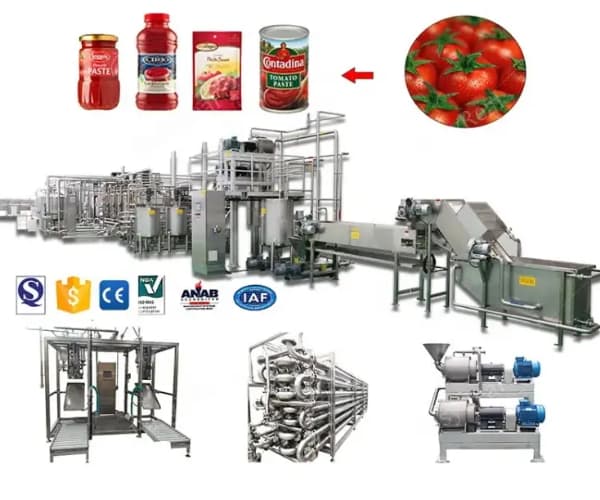
4. Sterilization and Concentration System
Sterilization and concentration improve shelf life and sauce quality.
4.1 Continuous Sterilizer
- 기능: Kills harmful microorganisms to ensure food safety.
- Technology: High-temperature short-time (HTST) sterilization
- Benefits: Maintains flavor and nutrients while extending shelf life
4.2 Vacuum Concentrator (Optional)
- 기능: Concentrates tomato sauce to increase thickness without compromising color or taste.
- Technology: Operates under vacuum to reduce boiling point
- 용량: 500–5,000 liters per batch
- Advantages: Produces thick, high-quality sauce suitable for commercial packaging
5. Filling and Packaging System
After cooking, mixing, and sterilization, the final step is filling, sealing, and labeling.
5.1 Tomato Sauce Filling Machine
- 기능: Automatically fills bottles, jars, or cans with prepared sauce
- Features: Adjustable filling volume, high-speed operation, stainless steel construction
- 용량: 500–3,000 containers per hour
5.2 Capping and Sealing Machine
- 기능: Seals containers to maintain hygiene and prevent leakage
- Types: Screw capping, vacuum sealing, induction sealing
5.3 Labeling and Coding Machine
- 기능: Applies labels and prints batch numbers, production dates, and expiration dates
- Importance: Ensures regulatory compliance and provides consumers with product information
The filling and packaging system ensures the sauce reaches consumers safely and efficiently.
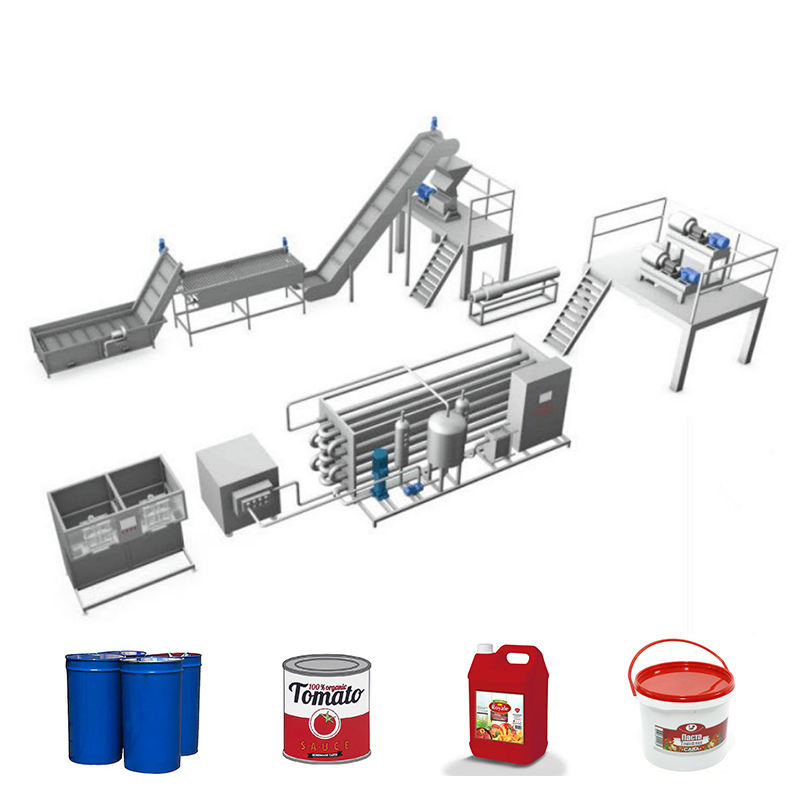
6. Auxiliary Components
Several auxiliary machines are crucial for the smooth operation of a commercial tomato sauce production line:
- Conveyor Systems: Move tomatoes, pulp, and bottles efficiently between machines
- Pumps and Piping: Transfer sauce and pulp with minimal loss
- Cleaning-in-Place (CIP) 시스템: Automatically clean tanks, pipes, and machines
- Control Systems: Centralized PLC or touchscreen systems to monitor temperature, speed, and production flow
These components ensure hygiene, 능률, and automation throughout the production process.
7. Advantages of a Commercial Tomato Sauce Production Line
Investing in a Commercial tomato sauce making machine offers numerous benefits:
- 고효율: Automation reduces manual labor and increases output
- Consistent Quality: Standardized processing ensures uniform taste, color, and texture
- Food Safety: Stainless steel construction, sterilization, and CIP systems maintain hygiene
- Scalability: Suitable for small, 중간, and large-scale production
- 비용 효율성: Reduces waste, energy consumption, and labor costs
By integrating these components, manufacturers can optimize production and produce high-quality tomato sauce for local and international markets.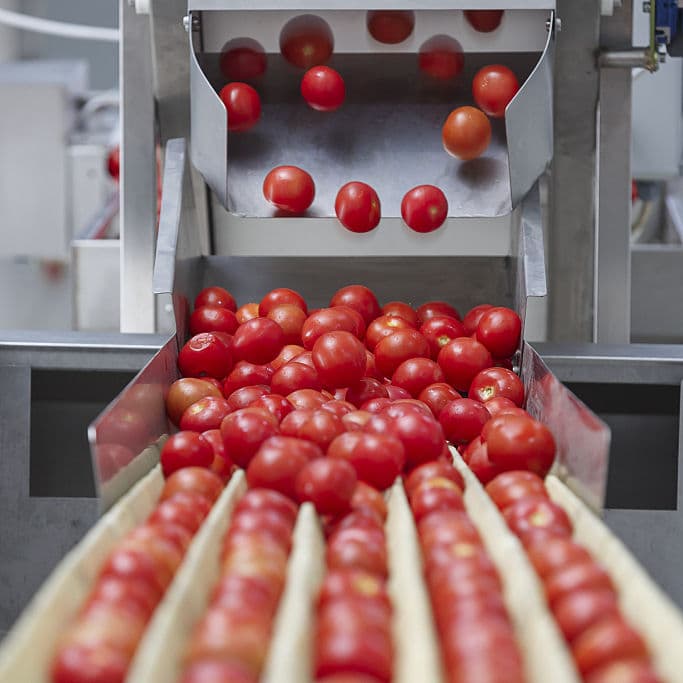
8. Technical Specifications Overview (Example)
| Component | 용량 | 힘 | 재료 | Feature |
|---|---|---|---|---|
| Tomato Washing Machine | 1–10 tons/h | 3–7 kW | Stainless steel | Bubble washing & brushes |
| Tomato Crusher | 500–5000 kg/h | 2–5 kW | Stainless steel | Roller/knife crushing |
| Tomato Pulper | 500–5000 kg/h | 3–6 kW | Stainless steel | Seed & skin separation |
| Sauce Cooker | 500–10000 L/batch | 10–50 kW | Stainless steel | Steam/electric heating |
| Sauce Mixer | 500–5000 L | 2–10 kW | Stainless steel | High-speed agitator |
| Sterilizer | 500–5000 L/h | 20–60 kW | Stainless steel | HTST sterilization |
| Filling Machine | 500–3000 bottles/h | 2–5 kW | Stainless steel | Adjustable filling |
| Capping Machine | 500–3000 bottles/h | 1–3 kW | Stainless steel | Screw or induction sealing |
| Labeling Machine | 500–3000 bottles/h | 1–2 kW | Stainless steel | Automatic labeling & coding |
RFQ – Commercial Tomato Sauce Making Machine
1. What is the production capacity of your commercial tomato sauce making machine?
Our machines can handle 500–10,000 liters per batch or 500–5,000 kg per hour depending on the model and configuration. We can customize the capacity according to your production requirements.
2. What raw materials are suitable for the machine?
The machine processes fresh tomatoes with uniform ripeness. It can also handle frozen tomatoes and other tomato-based ingredients for special sauce recipes.
3. What is the main material of the machine?
All contact parts are made of stainless steel (SS304 or SS316) to ensure hygiene, corrosion resistance, and durability.
4. Can the machine be fully automated?
예, we offer fully automated production lines including washing, crushing, pulping, cooking, mixing, sterilizing, filling, capping, and labeling.
5. What is the power consumption of the production line?
Power depends on the scale and configuration. Typically, washing machines use 3–7 kW, crushers 2–5 kW, cookers 10–50 kW, and sterilizers 20–60 kW.
6. Is the machine easy to clean?
예, the production line is equipped with Cleaning-in-Place (CIP) systems to ensure hygiene and minimize manual labor during cleaning.
7. Can the machine produce different types of tomato sauce?
예, by adjusting cooking time, mixing ratio, and concentration, the machine can produce standard tomato sauce, ketchup, and thick paste.
8. What is the warranty period?
Our machines come with a standard 12-month warranty and lifetime technical support to ensure long-term performance.
9. Do you provide installation and training?
예, DT Food Machine provides installation guidance, on-site commissioning, and operator training to ensure smooth production.
10. How can I get a quotation for a complete tomato sauce production line?
You can contact DT Food Machine via email or website with your production capacity, desired output, and packaging requirements. We will provide a detailed quotation including machine specifications, layout, 그리고 비용.
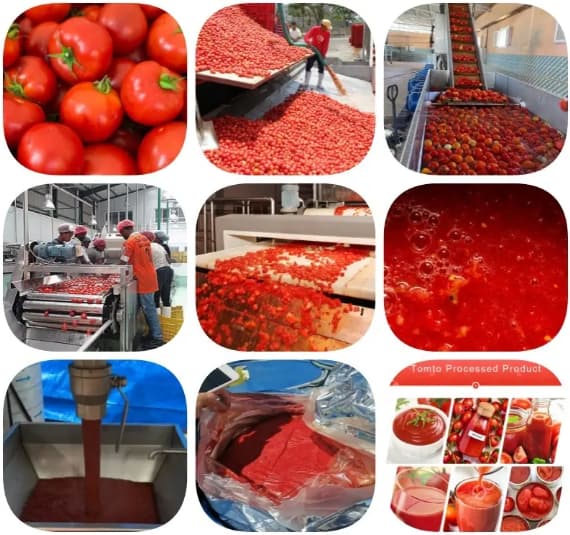
About Us- DT 푸드 머신
ㅏ Commercial tomato sauce making machine integrates washing, crushing, pulping, cooking, mixing, sterilizing, filling, and packaging systems into a streamlined production line. Each component plays a vital role in ensuring efficiency, product quality, and food safety.
For food manufacturers seeking reliable, high-performance tomato sauce production equipment, DT 푸드 머신 is a leading manufacturer of Commercial Tomato Sauce Making Machines, providing innovative solutions tailored to different production scales and market requirements.
